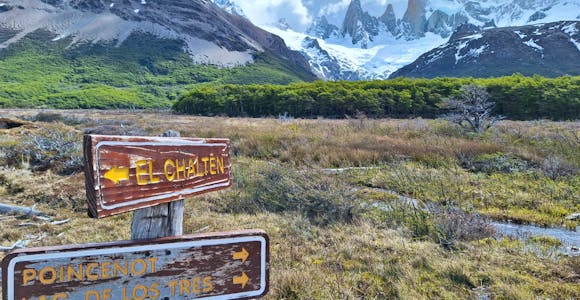
El Chaltén
Sat at the base of Mount Fitz Roy in Los Glaciares, the town of El Chaltén is one of the world’s greatest destinations for spectacular mountain day hikes and rock climbing.
Discover MoreDeep roots in Patagonia: We are ex-guides, tour leaders, outdoor enthusiasts, & adventurers.
We’ve got our feet on the ground: Impartial advice, a bespoke service, and at no extra cost.
For the ends of the Earth: Sustainability is more than our carbon footprint (but we’re reducing that too).

The Huemul Circuit is one of the best circular treks you can do in Los Glaciares National Park. It’s a challenging route but one that rewards those who tackle it with rare views of the Southern Patagonian Ice Field in all its vast frozen glory, dramatic mountain passes, wild camping next to beached icebergs and zipline crossings over river canyons. It’s an unbeatable adventure.
55.5km | 34.5 miles
4 days
Elevation gain: +7,434ft/2,267m
Elevation loss: -7,875ft/2,400m

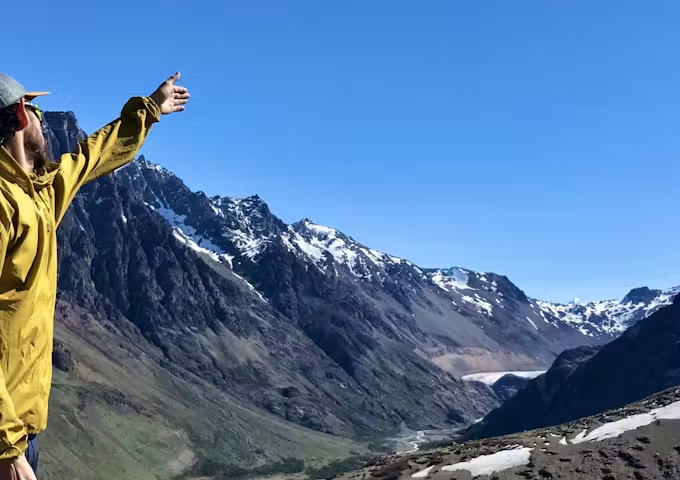
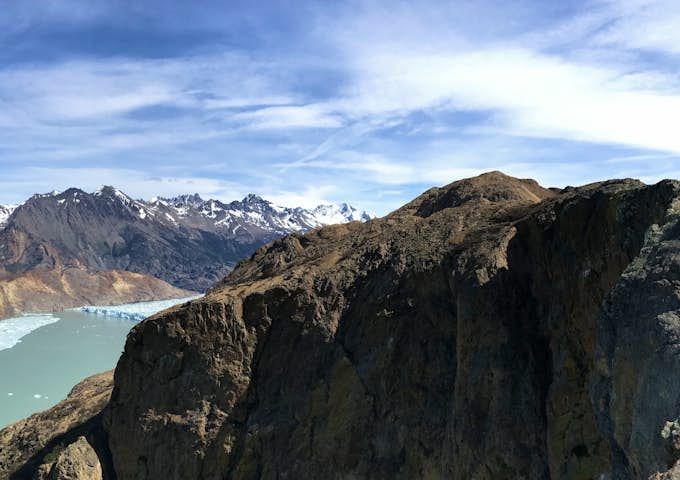


Climbing to the Huemul Pass

Swoop Specialist Tomas at Viedma Glacier

Start off in the flower meadows
The Tunel valley on day 1 Huemul Circuit
Distance 10 miles (16 km)
Elevation 2490 ft (760m) ascent, 1620 ft (490m) descent
The first day of the Huemul Circuit is designed to ease you into the trek. It has a full day of walking on a well marked and gently climbing trail, finishing at a wild camping site that puts you in prime position for the challenges ahead.
Like many of the best hikes in Los Glaciares, the trail starts by walking straight out of El Chaltén towards the mountains. The path undulates through the wide glacial valley, crossing sweeping meadows and accompanied throughout by tremendous views of Mount FiztRoy and Cerro Torre.
As the day progresses, the meadows become dotted with forests of native lenga and ñirre trees, as the terrain slowly rises into rolling hills.
The second half of the day treats you to views of Cerro Huemul. You’ll find the trail here to be crossed with a series of shallow streams that you’ll need to wade across. The water generally comes up to your knees at most. As you approach the campsite, the trail can also become quite marshy in places.
The day finished at Toro Camp (Campamento Laguna Toro), a wild camp that’s tucked into the lenga forest to offer shelter from Patagonia’s wind. Water can be obtained at the nearby glacier-fed river.
Tyrolean traverse on day 2 of the Huemul Circuit
Distance 10 miles (16 km)
Elevation 2720 ft (830m) ascent, 1890 ft (570m) descent
The second day of the Huemul Circuit is tough and tiring, and involves tackling a serious mountain pass, but it offers as a reward one of the greatest views in all of South America: the South Patagonian Ice Field.
The day starts by crossing the Túnel River. If the river is low, it’s sometimes possible to wade across upstream, but the normal method is by Tyrolean traverse: pulling yourself hand over hand along a zipline strung over the river. It’s a dramatic way to cross the threshold into the heart of Los Glaciares.
From here the trail winds slowly and constantly upwards, walking along the moraine that runs alongside the Glacier Rio Túnel Inferior, and surrounded by granite crags and snowy peaks. You’ll often find yourself walking on the scree-covered edge glacier itself, or rising high to look down on its icy blue tongue.
The goal is the Paso del Viento (Windy Pass). As the name implies, the weather can howl ferociously over this feature, as well as several false horizons to the pass. It’s all designed to test the grit of every trekker. When you crest the summit your efforts are repaid in full, as the endless frozen fields of the ice cap unfurl themselves in front of you on a scale that it’s hard to comprehend.
From the pass, it’s a gentle descent to the Paso del Viento campsite, next to a small lagoon amid grassy slopes. Take advantage of the rocky circular windbreaks erected for tents: you’ll be grateful for every inch of shelter on offer.
Looking out at the Viedma Glacier
The Southern ice field from Paso del Viento
Distance 8.7 miles (14 km)
Elevation1760 ft (535m) ascent, 3890 ft (1190m) descent
The third day of the Huemul Circuit sees more climbing, as the trail gains altitude to offer views of the Viedma Glacier before crossing the hike’s last major pass to descend to an iceberg-strewn lake.
The day begins with a steady climb towards Paso Huemul (Huemul Pass). As you walk you’ll continue to have the amazing ice field views – this time of the icebound moonscape of the Viedma Glacier, backed by snowy peaks.
The pass is less challenging than the previous day, though you should still be prepared to battle strong winds. When you reach the top, there are more amazing views of where the enormous river of ice meets its end, as it breaks and drains into the milky blue waters of Lake Viedma.
The lake now acts as your constant companion as you begin a steep and sometimes difficult descent to its waters. The trail descends incredibly quickly, so it’s essential to take this section of the hike as slowly as possible. The terrain is rocky, broken with low trees that provide shelter from the wind.
Eventually the gradient starts to ease up, to give a straightforward downhill section leading towards the campsite at Bahía de los Témpanos.
This bay of icebergs is a perfectly named spot, and as you slowly approach it it’s a thrill to see the distant white blocks resolve into icebergs the size of buildings, piled up close to shore. The campsite is sheltered amid trees a short walk from the beach.
Bahía de los Tempanos
Tyrolean traverse on day 4 of the Huemul Circuit
Distance 10 miles (16 km)
Elevation 1370 ft (420 m) ascent, 1360 ft (420m) descent
The fourth day of the Huemul Circuit is the most relaxed of the hike. There are no major changes in elevation over the day, just a steady walk through gorgeous scenery that allows you to process the experience of the trek as a whole.
After striking camp (perhaps after taking your breakfast by the icebergs on the beach) you follow a trail through pampa away from the lake. Stick to the trail: there are several small streams to cross, but it’s easy to get stuck in the scrubby bush, which is dotted with sections of marsh. Don’t forget to regularly look back at the ice cliffs of the Viedma Glacier as they recede into the distance.
After a gentle climb above the lake, the trail descends to meet the lower Túnel River. This is the river you crossed on the second day of the trek: meeting it again is what makes the route a circuit. Crossing the river here again requires a Tyrolean traverse using a zipline. At the start of your hike the crossing might have seemed daunting, but now you’ll pull yourself across with all the experience of an old hand.
The river effectively marks the end of the trek. From here, El Chaltén is just five miles (8 km away). Completists may want to walk this last stretch, but most trekkers are content with having transport meet them immediately after the river crossing to take them back to town.
The rocky moraines on the Huemul Circuit can be really tough on the knees. We strongly recommend taking a pair of trekking poles for extra support and to reduce the chances of knee strain, particularly on the steep descent from the Huemul Pass on day three.

Sat at the base of Mount Fitz Roy in Los Glaciares, the town of El Chaltén is one of the world’s greatest destinations for spectacular mountain day hikes and rock climbing.
Discover More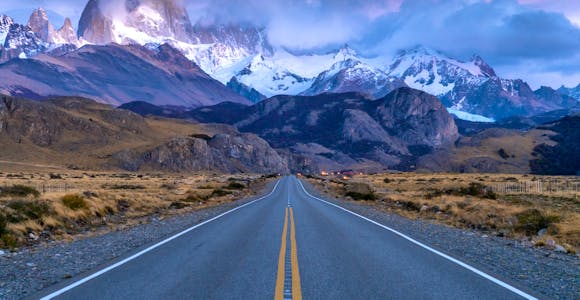
Whether you’re travelling from Buenos Aires, Torres del Paine or beyond, Los Glaciares is easy to get to from across Patagonia.
Discover More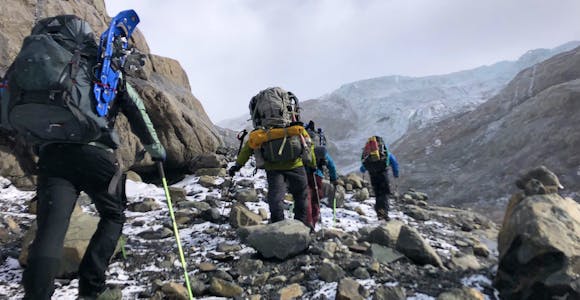
Los Glaciares offers extraordinary multi-trekking adventures, sleeping under the stars to explore Mount Fitz Roy, hanging glaciers and hidden valleys.
Discover More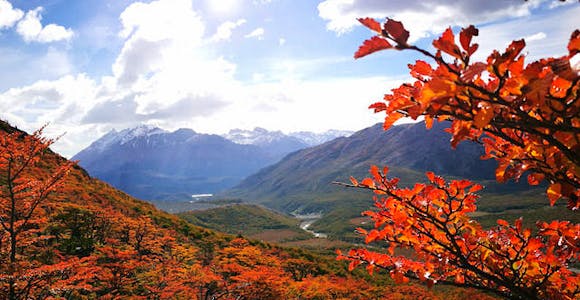
Get to know the different seasons of this diverse region, from the long days of the Patagonia summer to the first snows of winter.
Discover MoreHuemul Circuit guide trips scored 4.3/5 from 18 reviews
This is a most beautiful part of the world and to have the opportunity to explore it on foot was truly wonderful. We were also very lucky with the weather! Read the full review
Travelled: December 2022
Lynne Harris - USA
Trekkers on the Huemul Circuit carry camping equipment, food and clothing, so bring a suitably-sized rucksack: we recommend 55-65 litre capacity. You'll need a sleeping bag rated for 10F (-12C) and inflatable sleeping mat. A 4-season tent is essential, especially for the strong winds.
Dress for four seasons in a single day, with a windproof and waterproof jacket and warm layers including a warm hat, neck gaiter (buff) and windproof gloves. Waterproof hiking boots that support your ankles are a must, plus sandals for river crossings and trekking poles.
The National Park rangers will check that you are carrying several compulsory items, for managing the Tyrolean traverses. All trekkers must bring a harness, two carabiniers and a safety line; all groups must also carry a thin cord of at least 20 m length. A map and camping stove are also essential.
On our guided treks all technical gear for the tyrolean traveses, tent, stove and food are included so you just need to bring your own backpack, trekking poles, sleeping bag, sleeping mat and clothing/footwear.
You can find outdoor gear shops in El Chaltén selling new and pre-owned kit. Porters can also be arranged to carry some of your gear.
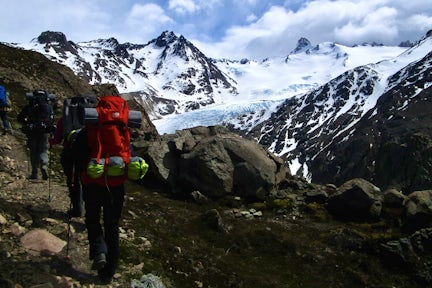
The Huemul Circuit is aimed at experienced trekkers with a very high level of fitness. You’ll need to be prepared to carry a heavy rucksack over some challenging terrain under a variety of different (and often harsh) weather conditions.
Where your fitness will be tested is not in the distance walked, but the ever-changing nature of the trail. Uneven and rocky moraine, steep descents, unpredictable trails and Tyrolean traverses are all part of the fun you’ll need to be prepared for. On top of this, the Circuit’s two main passes can be particularly tough when you’re climbing with all your gear into the teeth of a wind that’s doing its very best to knock you flat off your feet.
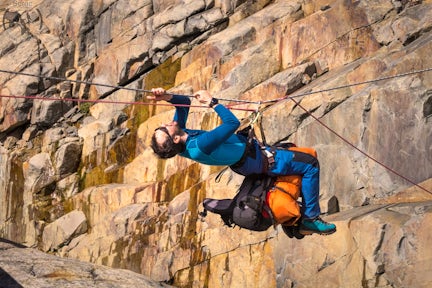
While you’ll be wearing good hiking boots with ankle protection for most of the Huemul Circuit, bring a pair of sandals for wading across rivers as well as relaxing in camp.
There are three campsites on the Huemul Circuit. All are basic. The first campsite, at Laguna Toro) has a simple long-drop toilet, while the others have designated toilet areas. Laguna Toro and the second campsite at Paso del Viento have simple shelters for refuge and cooking in, otherwise they are real back country camping affairs.
You'll be expected to carry the food you’ll eat as well as your tent. This will add around 9–11 lbs (4-5 kg) of weight to your rucksack. If you prefer, it is possible to arrange a porter in El Chaltén to carry part of your gear, though they will only carry up to around 26 pounds (12 kg).
A camping stove is a mandatory piece of kit; campfires are not permitted. If you are trekking with a guide, they will cook for you, otherwise you must be entirely self-supported. Water is taken from glacial-fed streams – some of the purest water on the planet.
The entire expedition operates on the ‘Leave no trace’ principle, so you must carry all waste out with you from the trek.

This is a challenging trek. As well as a very high level of fitness, you will need experience in similar remote treks, carrying a heavy backpack for multiple days.
You can do the trek the Huemul Circuit from November to March. While the ice cap is permanent, spring and autumn can still bring snow at the lower altitudes. The 18 hour long summer days can tend to being the clearest skies, but the winds can be strongest at this time of year.
Whenever you travel, be prepared for extreme weather conditions.
This is only one step above a wild camping trip, so you will be constantly up close to nature, pitching your tent in spectacular landscapes. There are no showers, and only one campsite has a long-drop toilet.
To eat, unless you're on an organised trek, you'll need to be entirely self-sufficient when it comes to food. A camp stove is a mandatory piece of kit; campfires are forbidden. Pure drinking water is taken direct from glacial streams.
It is compulsory for all trekkers to carry two carabineers, a harness, rope and safety line for the Tyrolean traverse. A map and camping stove are also compulsory.
Everything you need you will have to carry, unless you arrange a porter. You will need a sleeping bag rated for 10F (-12C) and inflatable sleeping mat, plus a tent rated for four seasons.
If you are trekking with. a group, the technical gear for the traverse will be provided, along with a tent. Gear can be rented in El Chaltén.
If you are part of an organised group, it is possible you may need to share. Camping spots are limited during this expedition so you might need to share a tent with another trekker, or possibly a guide.
Porters can be arranged when you're booking the expedition. A porter can carry up to 27 lbs (12kg), so you will still have to carry a rucksack – they are just there to help lighten your load.
For much of the Huemul Circuit the trail is completely unmarked. While experienced trekkers may attempt the circuit self-guiding with a map and GPS, the remote and challenging aspects of the trek such as the Tyrolean traverse and the glacier crossing, coupled with the predictability of the weather mean that we strongly advise doing the Huemul Circuit trek with an experienced guide.
The Huemul Circuit offers views across the South Patagonian Ice Field and the chance to walk along the edge of the Viedma Glacier so you will definitely get the opportunity to walk on some very big ice.
The trek does not traverse any upper sections of the ice field or offer the chance to camp on it. If you're interested in that, check out our South Patagonian Ice Field Expedition trip.
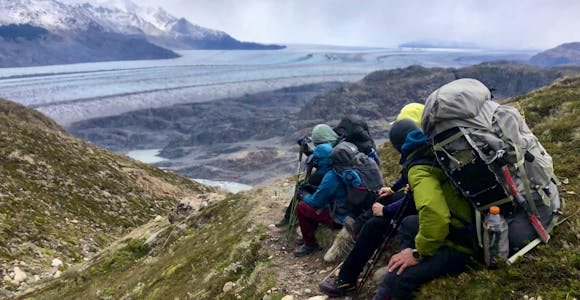
Perfect for tried and tested trekkers, these iconic routes in Torres del Paine, El Chaltén and Tierra del Fuego are expertly guided for a fully immersive experience.
Discover More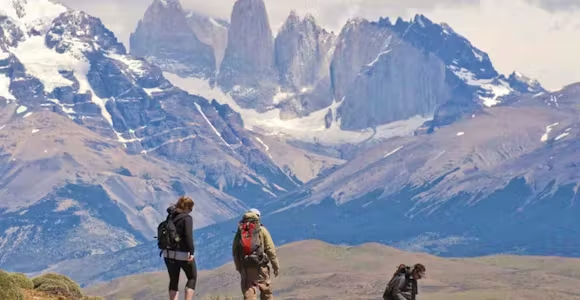
The W Trek is Torres del Paine most famous hiking route, which can be walked in a variety of ways, from a multi-day trek to a series of day hikes.
Discover More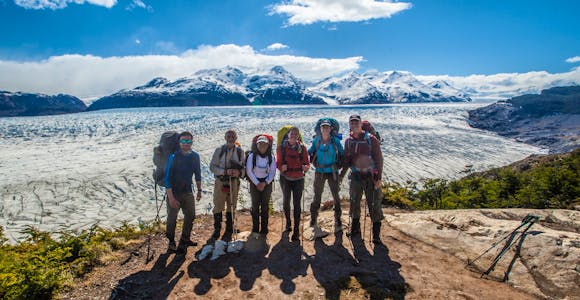
The O Circuit is a great trek for experienced hikers, spending over a week to explore both Torres del Paine’s most popular sights and its quieter trails.
Discover MoreWe'll spend some time listening to your aspirations, then discuss the kind of experience that might suit you.
Next we'll discuss the options, shortlist the best trips for you and present you our impartial recommendations.
We'll place a 24 hour hold on your preferred option - without obligation - whilst we talk through the details.
This website uses cookies to ensure you get the best experience on our website. Privacy policy